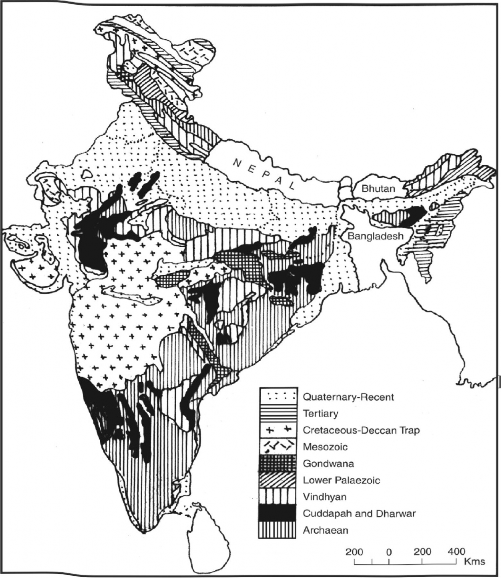THE ARCHAEAN FORMATIONS (PRE-CAMBRIAN)
The Archaean Era is also known as the Precambrian Period. This is the division of geologic time scale from the formation of the Earth (about 4.6 billion years ago) to the beginning of the Cambrian Period of the Paleozoic Era (about 570 million years ago).
The Precambrian time constitutes about 86.7% of the Earth’s history. The term ‘Archaean’, introduced byJ.D. Dana in 1782, refers to the oldest rocks of the Earth's crust. The oldest known rocks of the Earth, the evolutionary atmosphere, the first chemosynthesis, the first photosynthesis, the life-supporting atmosphere and the Earth’s modern atmosphere, were developed during the Precambrian Era [Archaean and Protozoic), Rocks of the Archaean System are devoid of any form of life. In other words, the Archaean rocks are all azoic or unfossiliferous. They are thoroughly crystalline, extremely contorted and faulted, and practically devoid of any sediment. They are largely intruded by plutonic intrusions and generally have a well-defined foliated structure. These rocks are known as the basement complex or fundamental gneisses. Thus, all over the world, the Archaean rocks are the foundation of all the great ancient plateaux, and they form the core of all the great folded mountain ranges of the world.

Fig. 1.1 Geological Systems
In the Indian Geological Time Scale, advocated by T.S. Holland, the Pre-Cambrian Era is known as the Purana. The Archean System includes the AravaUi, Dharwar, Cuddapah, Vindhyan, Meghalaya Plateau and Mikir Hills. These are also called the Archean gneiss. The mineral composition of Archaen gneiss varies from granite to gabbro. The constituent minerals are: orthoclase, oligoclase, quartz, muscovite, biotite and hornblends. The Archaen rocks cover two- thirds of Peninsular India. They also occur in the roots of the mountain peaks all along the Greater Himalayas from the western most part of Kashmir to the eastern-most part of Arunachal Pradesh as well as in the Trans-Himalayan ranges of Zaskar (Zanskar), Ladakh and the Karakoram (Fig. 1.1 and Fig. 1.2).
The Archaean rocks cover two-thirds of Peninsular India. In the Peninsular region, the Archaean rocks are known to be of three well-defined types:
